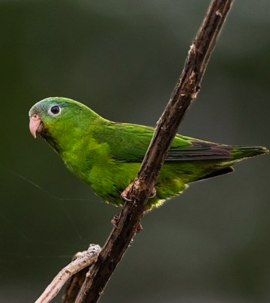Amazonian Parrotlet |
|
|
Also known as: Manu Parrotlet
Photos
View in GalleryDid You Know?
The Amazonian Parrotlet was first discovered in 1991.Academic Research
Related publications: Nannopsittaca dachilleaeSpecies Profile
Genus: Nannopsittaca | Species: dachilleae
Size:
12cm (4.68in)
Weight:
38-46g.
Subspecies including nominate:
one
Colour Adult:
Both adults mainly yellow/green in colour; light blue lores, forehead and forecrown; yellow/green cheeks and chin; olive wash to mantle and lesser wing coverts. Bill pale pink. Eye brown.
Colour Juvenile:
Not recorded.
Call:
Calls are described as high-pitched and piping, sounding very like domestic fowl chicks.
Listen NowMore Information:
Content Sources:
CITES
BirdLife International
Cornell Lab of Ornithology/Birds of the World
A Guide to Parrots of the World, Juniper and Parr, 1998.
ML Audio 43229, Amazonian Parrotlet, (Nannopsittaca dachilleae), Tambopata, Parker, Theodore A., III, Peru, Aug. 1988, Cornell Lab of Ornithology. Site
Parrots of the World, Forshaw, 2006. 2010 edition
Photos
View in GalleryDid You Know?
The Amazonian Parrotlet was first discovered in 1991.Academic Research
Related publications: Nannopsittaca dachilleaeSpecies Care
Captive Status:
Not found in aviculture.
Longevity:
Not recorded.
Housing:
Not recorded.
Diet:
Not recorded.
Enrichment:
Not recorded.
Nest Box Size:
Not recorded.
Clutch Size:
Not recorded.
Incubation Time:
Not recorded.
Fledging Age:
Not recorded.
Hatch Weight:
Not recorded.
Peak Weight:
Not recorded.
Weaning Weight:
Not recorded.
Photos
View in GalleryDid You Know?
The Amazonian Parrotlet was first discovered in 1991.Academic Research
Related publications: Nannopsittaca dachilleaeSpecies Wild Status
World Population:
About 10,000
IUCN Red List Status:
Least Concern
CITES Listing:
Appendix II
Threat Summary:
Not globally threatened. Common to abundant at different localities and present in Tambopata Reserve and Manu National Park. This species' habitat has been subjected to oil exploration, mining and some logging.
Range:
Western Amazon River basin, where recorded in E Peru from Iquitos district, Loreto, drainages of Rio Ucayali, Ucayali and Rio Manu, Madre de Dios, and along Rio Heath, La Paz, NW Bolivia.
Habitat:
Found up to 300m (984 ft) in lowland forest near rivers and streams, Calocophyllum and Cecropia sp. treed areas, and bamboo groves.
Wild Diet:
Feeds on fruits and also Cecropia catkins, fruits or seeds of an arboreal epiphytic cactus Rhipsalis, Vernonia and Guadua bamboo seeds, and ripe fruits of Coussapoa vine.
Ecology and Behaviour:
Social and active; forms flocks of up to 12 individuals. Frequents mineral-rich river banks with other parrots.
Clutch and Egg Size:
Not recorded.
Breeding Season:
Possibly July-September; one nest cavity recorded in epiphyte clump.
Related Links:
Photos
View in GalleryDid You Know?
The Amazonian Parrotlet was first discovered in 1991.Academic Research
Related publications: Nannopsittaca dachilleaeMembers Only Resources
Please log-in now to find more research, resources and tools.
Not a Member?
Find more great information:
Gain exclusive access to 600+ pages of additional research, seminars and podcasts, specialists to ask your toughest questions, and dozens of other fun resources - when you become a WPT member.
Join Today >>

































